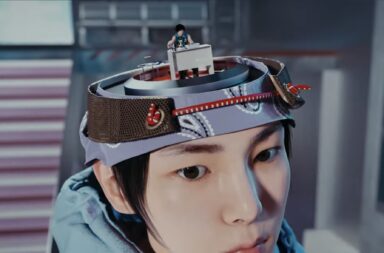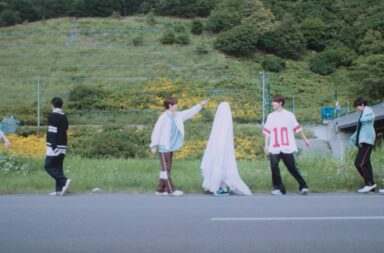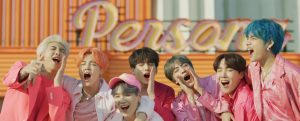
My cousin once described the Chicken Little movie in this manner: “The only highlights were all in the trailer.” Unfortunately, the same can be said of BTS‘ “Boy with Luv”, the MV opening their new Map of the Soul series. Like preceding MVs in the Love Yourself series, “Boy with Luv” has landed on conceptual gold. But like those MVs, it fails to exploit the full potential of its concept. In fact, it does worse. The Love Yourself MVs may not have produced a satisfying narrative arc for the series, but they were committed to giving visual form to their individual themes, and fully showcased BTS’ magnetism as performers. In comparison, “Boy with Luv” only barely engages with its concept, and as a performance-based MV, it is marred by bland camerawork. It is, in a word, generic—a word I never imagined I’d use to describe a BTS MV.
Make no mistake: I didn’t approach this MV preparing to dislike it. When the name of the album and its theme (persona) was announced, I was excited. The idea of personas is a logical continuation of BTS’ long-standing interest in the theme of growth, and their corresponding explorations of self and identity. This interest sometimes manifests in more universal messages (the School trilogy, the Most Beautiful Moment in Life cycle, and Love Yourself: Tear), while at other times, it leans towards more personal reflections (Wings, Love Yourself: Answer, and rap line’s solo mixtapes). The title of the track, “Boy with Luv”—being a clear nod to their 2014 release “Boy in Luv”—immediately evokes the sense of how BTS have grown as artists with the help of their fans’ support. It’s a clever choice that acknowledges and owns their previous identities, while at the same time signalling that they’ve moved on.
Going by the MV’s title alone, it makes sense to approach the MV’s content with two versions of the same question. If you don’t know much about BTS, the unusual choice of preposition might pique the casual viewer’s interest in what characterises a boy with love, as opposed to a boy in love. Those acquainted with BTS, on the other hand, might take this point of curiosity a step further to wonder what this release signifies for their artistic growth. A boy with love is a focused theme that’s easy to understand, but also open enough to be explored in just about any way visually. Given this, it’s disappointing that so little of the MV tries to flesh out this theme.
To clarify, I don’t have a fixed idea of what BTS MVs are supposed to be like. But whether they choose to focus on choreography, symbolism, or a storyline, they often have these strengths: creative, purposeful styling—sets, props, costumes, lighting—that visually captures the theme(s) of the song; dynamic camerawork; and a powerful, magnetic performance made possible by these two factors. Because “Boy with Luv” is lacking in its visual choices and camerawork, it falls short on showcasing BTS’ performance as well. It’s a lapse that’s difficult to imagine until you actually witness it. We are, after all, talking about a group capable of creating a captivating MV with no more than casual clothing, a muddy plain, and their dancing.
To set a reference point for the shortcomings of “Boy with Luv”, it is worth recapping a few highlights from similarly choreography-heavy BTS MVs by the same director, Lumpens. “DNA” made clever editing choices right from its opening shot, pulling back from a CG image of a galaxy into a graphically matching extreme close-up of Jungkook‘s eye. The camera never stops moving; it zooms in and out, tracks left and right, tilts around. At one point, it even moves in an unusual 180-degree overhead arc to create the illusion that Jungkook and V are defying gravity and standing on two sides of the same platform. There are no complicated messages to be decoded here; the effect is intuitive, as the camerawork mirrors the energy of the choreography itself. “Fake Love” uses grandiose sets in a state of ruin to emphasise its theme of a relationship that has broken down. Even “Just One Day” from way back, with its visibly tighter budget, employs light and shadow to add surprising touches to its straightforward choreography shots.

Whether the concepts and visuals are complex or simple, a certain thoughtfulness pervades each BTS MV. It is this thoughtful quality that “Boy with Luv” sorely lacks. The MV doesn’t do much to show what characterises the titular persona, a boy with love. I get that this MV is supposed to be a lot more laid-back than previous BTS MVs, but laid-back doesn’t have to be flat. Case in point: BTS’ Puma Turin CF uses slow camera movements and soft lighting, and weaves in visual echoes of their previous videos (a shot of RM reaching out for J-Hope‘s arm that parallels a scene from “The Most Beautiful Moment in Life on stage: prologue”, an apple and a swing for the Wings short films and tour trailer, a merry-go-round for “Spring Day”). The effect is gentle but poignant, reminding the viewer of BTS’ relationship with Puma, the first major brand to offer them a CF deal.
But let’s back up a bit, and talk about the artistic choices of “Boy with Luv” that do seem to tie in with the theme. There’s the exterior of a vintage-style theatre, as well as a painted landscape of street lamps with a city skyline that is reminiscent of musical sets. The viewer might be expected to infer that these are meta references to BTS’ personas as performers. I say “might”, because such sets have been used in other K-pop MVs before, simply as backdrops.
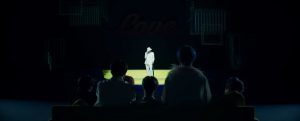
As such, if the intent is to be self-referential, the use of this set needs sustained effort to differentiate it from the common decorative use. There is only a faint attempt at this, towards the end of the MV, with RM performing in the spotlight on a stage and his members watching him. Do they represent their fans, or themselves—in which case, is this representative of the way they look at this particular identity of theirs, as performers and public figures? If so, what does it say about their thoughts and feelings towards this identity?
Sunmi‘s “Siren” is an example of a MV that explores these questions by repeatedly presenting images of Sunmi running into her “Gashina”-performing doppelganger. She reacts with shock, slight annoyance, and resignation, as if she can never quite get used to the part of her that’s an artist. I don’t expect “Boy with Luv” to deliver the same answers, but I do think it’s fair to ask for a greater level of engagement with the themes that it raises. When the marquee signs above RM light up, displaying the titles of their previous albums, the boys rush towards the stage to join him. But the significance of this moment is not made clear.
The closest the MV comes to illuminating what characterises a boy with love is the ending shot, which is featured in the MV teaser. Facing a huge marquee sign spelling “Love”, BTS stand in the same formation as the ending pose of their “Boy in Luv” choreography. In “Boy in Luv”, they spin into the pose; the strength with which they enter it aligns with the masculine aggression of the choreography and MV as a whole. Here, though, they ease into the pose with a relaxed confidence.
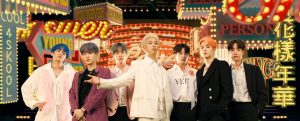
The contrast makes for a powerful moment. Gone are the boys who once relied on misguided gestures filled with bravado and romanticised violence to prove their growth. In their place, a more mature BTS stands, their actions slower, but surer, informed by the knowledge that they don’t need to rely on facades of strength to be loved, and that this knowledge, more than any external action, is one of the strongest sources of confidence.
If just this one frame can hit home with such a striking message, why is it that the rest of the MV refuses to engage with the ideas presented here? I can strain to make a point out of the choice of pink, comfortable clothing to contrast with the structured, boyish ruggedness of the school uniforms BTS don in “Boy in Luv”. But the contrast is not made explicit, unlike the purposeful use of clothing in RM’s comeback trailer, “Persona”, that visually echoes his daily wear and the styling of past MVs and stages. It doesn’t even take someone who knows BTS’ past releases to discern that the various sets of clothing RM wears represents different facets of his identity, and to understand that the white clothing he wears towards the end symbolises an unknown persona that is still in formation. BTS wear something similar in “Boy with Luv”, but it’s not certain what the colour symbolises in the particular context of this MV. Whatever attempts there are to present the theme are very oblique, executed almost as an afterthought.
Full disclosure: I am writing this review from a biased point of view. Before I was even a writer here, I was a BTS fan. The sincerity of “N.O” and O!RUL8,2? made me pay especial attention to their music in the already overcrowded K-pop scene back then, and the Most Beautiful Moment in Life series reeled me in. I’ve examined different aspects of BTS’ work in every BTS era since 2016, the year I joined the site. I’ve analysed the symbolism of the Most Beautiful Moment in Life trailers and MVs, contributed a reading of the “Blood Sweat and Tears” MV as a Künstlerroman, deep dived into the simple but effective metaphors in the lyrics of You Never Walk Alone, and highlighted the theme of vulnerability in their B-sides.

Looking at BTS’ releases through a more critical lens filled me with an even deeper sense of respect—not just for the members who contributed to their material, but also for Big Hit’s creative team and their external collaborators who gave form to these personal voices and ideas. They had not just the technical finesse to pull it off, but also the dedication to go above and beyond what any of us expected from a music release. They’ve built entire artistic experiences out of comebacks, and even the simpler MVs have been visually and conceptually engaging. I’ve seen enough to trust them with whatever direction they choose to take, and I admit that because of this, I try harder than I usually do for other groups to understand where BTS’ team is coming from with each release.
So what’s going on with “Boy with Luv”? A skim through the credits reveals that the creative team hasn’t changed. They clearly don’t lack the skill or the resources to execute a good MV, and they’re certainly not given subpar concepts to work with. Is the problem then a lack of intent and will to follow through with the execution of the concept?
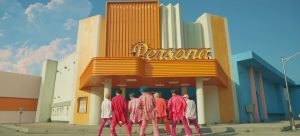
If you’ve stayed with me up till this point, you should have already realised that this is not a review written with all the glee of an anti-fan. This is written with the dread of a long-time fan, who is trying, but failing, to quell rising suspicions that the decision-makers behind BTS’ releases are starting to coast on the group’s popularity. They now seem content to market unique, relatable messages to create hype, without actually putting in the effort they used to in order to deliver these messages, because they know fans love BTS enough to support them anyway. The irony of this is that it reneges on the very source of this support: the artistic effort that has won the hearts of legions of fans and brought the group to where they are today.
(YouTube. Images via Big Hit Entertainment.)

